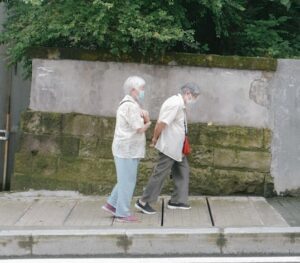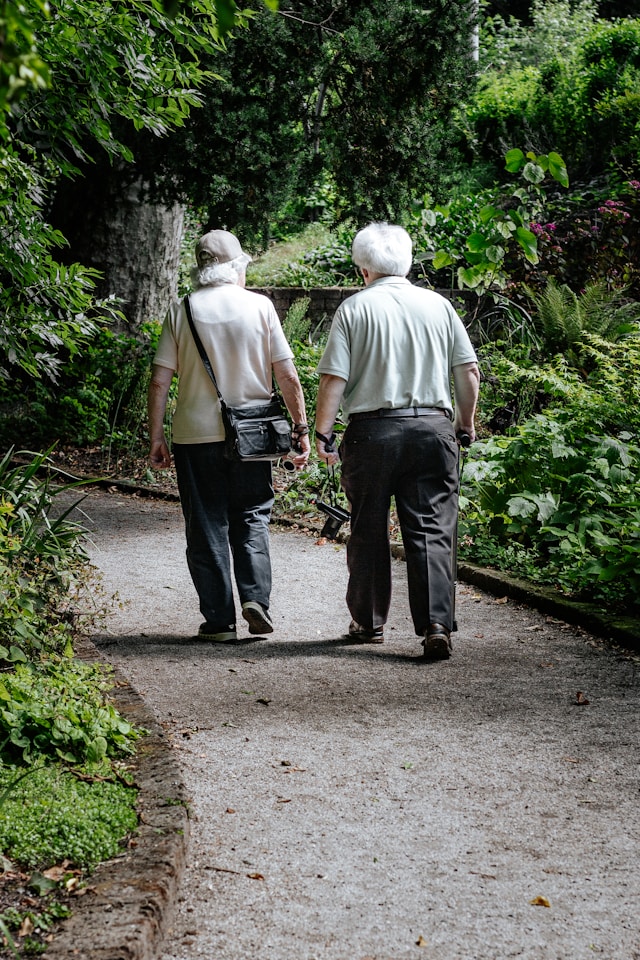Page Contents
Walking is a fundamental activity that many of us take for granted. Yet, for the elderly, especially those residing in nursing homes, regular walking can be a game-changer. As an administrator working in a nursing home, I have witnessed firsthand that many elderly tend to lie in beds or sit in wheelchairs throughout the day. This blog aims to highlight the myriad benefits of walking for the elderly and provide practical tips for safely and effectively promoting this activity in nursing homes.
The simplicity of walking
Walking is one of the simplest forms of exercise that requires no special equipment or training. It is accessible to most elderly individuals, regardless of their fitness levels. The beauty of walking lies in its simplicity and adaptability. Whether it’s a slow stroll around the garden or a brisk walk through the hallways, walking can be tailored to fit the individual needs and capabilities of each resident.

Why the elderly not walking?
The reasons why elderly individuals often prefer to lie in bed or sit in wheelchairs instead of walking involves multiple underlying factors. These factors can be categorised into physical, psychological, environmental, and social aspects.
Physical limitations
Chronic health conditions
Many elderly individuals suffer from chronic conditions such as arthritis, osteoporosis, heart disease, diabetes, and gout which can cause pain, stiffness, and fatigue. These conditions can make walking difficult and uncomfortable.Muscle weakness and balance issues
Ageing naturally leads to muscle atrophy (sarcopenia) and decreased balance. This makes walking more challenging and increases the risk of falls, leading many elderly individuals to avoid walking to prevent injuries.Mobility impairments
Conditions such as stroke, Parkinson’s disease, and other neurological disorders can severely impair mobility, making walking difficult or impossible without assistance.
Psychological factors
Fear of falling
The fear of falling, which is often exacerbated by previous falls or injuries, can be a significant deterrent to walking. This fear can lead to a preference for sitting or lying down, where they feel safer.Depression and anxiety
Mental health issues, including depression and anxiety, can reduce motivation and energy levels, making physical activity like walking less appealing.
Environmental barriers
Lack of accessible walking spaces
Nursing homes or living environments may lack safe, accessible, and inviting walking areas. Poorly designed spaces with obstacles, poor lighting, or uneven surfaces can discourage walking.Inadequate support
The absence of adequate support, such as walking aids or assistance from caregivers, can make walking seem daunting. Without the necessary support, elderly individuals might opt for the safety of a wheelchair or bed.
Social and behavioral influences
Sedentary lifestyle
Long-standing habits of a sedentary lifestyle can carry into old age. If an individual has not been active throughout their life, they are less likely to start walking regularly in their later years.Isolation
Social isolation and lack of companionship can diminish the motivation to engage in activities like walking. Having a walking buddy or a group can significantly enhance the willingness to walk.
Why walking is beneficial to the elderly
The benefits of walking for the elderly are manifold, encompassing physical, psychological, and social dimensions.
- Physically, regular walking is a low-impact exercise that significantly improves cardiovascular health by enhancing circulation and lowering blood pressure. It strengthens the heart, reducing the risk of heart disease, and helps regulate blood sugar levels, which is crucial for managing diabetes. Walking also strengthens muscles and bones, which is vital for preventing osteoporosis and maintaining overall mobility.
One of the most critical physical benefits of walking is its impact on balance and coordination. As we age, the risk of falls increases due to declining muscle strength and joint flexibility. Walking regularly helps to enhance proprioception—the body’s ability to sense movement, action, and location—which improves balance and reduces the likelihood of falls. This is particularly important for elderly individuals, as falls can lead to severe injuries and prolonged recovery times.
Walking also promotes joint health by keeping them flexible and lubricated. This can be particularly beneficial for those suffering from arthritis, as it reduces stiffness and pain. Additionally, walking aids in weight management, which is crucial for reducing the strain on joints and preventing obesity-related health issues. - Beyond the physical benefits, walking has substantial psychological advantages. Regular physical activity, including walking, is known to release endorphins—often referred to as “feel-good” hormones. These endorphins help alleviate symptoms of depression and anxiety, which are common among the elderly due to factors like isolation, loss of independence, and chronic health conditions. Walking provides a natural boost to mood and mental well-being, fostering a positive outlook on life.
- Socially, walking can be a highly interactive activity. Group walks or walking with a companion encourages socialisation, reducing feelings of loneliness and isolation. This social interaction is crucial for mental health and can lead to the formation of new friendships and stronger community bonds within the nursing home environment. Furthermore, engaging in regular walking routines can instill a sense of purpose and routine, contributing to a resident’s overall sense of independence and self-worth.
Spice up your walking
Choosing the best time for walking can maximise its benefits. Early mornings and late afternoons are ideal, as temperatures are usually moderate and the air is fresh.
Walking can be combined with other activities to make it more enjoyable. For instance, social walks with fellow residents can foster community bonds, while nature walks can be educational and soothing. Incorporating light stretching exercises before and after walking can further enhance flexibility and prevent injuries.

Safety considerations for walking
While walking is generally safe, certain precautions should be taken to ensure the well-being of elderly walkers. It’s crucial to choose safe and even terrains to prevent trips and falls. Be especially mindful of wet floors, as they can be extremely slippery and pose a significant fall risk.

Proper footwear that provides good support and fits well is essential. Appropriate attire for the weather, staying hydrated, and monitoring blood pressure before and after walks are also important. For those with mobility issues or balance concerns, using walking aids like canes or walkers can provide additional support.
Conclusion
Walking is a simple yet profoundly effective activity that offers numerous physical, mental, and social benefits for the elderly. As caregivers and healthcare professionals in nursing homes, it is our responsibility to encourage and facilitate regular walking opportunities for our residents. For example, encouring ambulant elderly to walk to dining area instead of serving foods on their beds, placing newspapers and reading materials at living room to nudge elderly get up from bed, bringing elderly for regular morning walk at gardens and parks. By integrating walking into their daily routines, we can help them lead healthier, happier, and more fulfilling lives. Let’s take the first step today and make walking a cornerstone of our elderly care programs.
